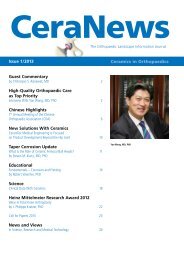BIOLOX - Nanocomposite for Arthoplasty
The Fourth Generation of Ceramics
The Fourth Generation of Ceramics
Create successful ePaper yourself
Turn your PDF publications into a flip-book with our unique Google optimized e-Paper software.
<strong>BIOLOX</strong> ® delta Minimizes Stripe Wear<br />
A manageable problem<br />
Occasionally in hip arthroplasty, the acetabular<br />
cup cannot be implanted in the ideal<br />
position. Such cases are particularly prone<br />
to subsequent micro-separation whereby<br />
the ball head retracts slightly from the cup<br />
when it is not loaded. With the next step<br />
of the patient, the ball head is pressed back<br />
into its original position and exposed to<br />
considerable edge loading. In hard-on-hard<br />
bearings, this can lead to stripe wear in<br />
particular zones of the femoral head and<br />
on the rim of the cup.<br />
Specific Testing<br />
The materials <strong>BIOLOX</strong> ® <strong>for</strong>te and <strong>BIOLOX</strong> ®<br />
delta (as well as combinations of these<br />
materials) show significant per<strong>for</strong>mance<br />
differences in tests designed to simulate<br />
micro-separation in the motion cycle. The<br />
stripe wear was highest in the <strong>for</strong>te-<strong>for</strong>te<br />
combination and lowest in the delta-delta<br />
combination. This difference can be seen<br />
in the run-in phase of the first million<br />
cycles and in the following steady state.<br />
While stripe wear has been observed in all<br />
hard-on-hard bearings, it does not represent<br />
a risk in ceramic bearings. “Of all<br />
hard-on-hard wear couples, bearings made<br />
of <strong>BIOLOX</strong> ® delta are best at resisting the<br />
phenomenon of stripe wear, both on the<br />
13<br />
Stripe wear after wear<br />
test under severe microseparation<br />
(2mm). The<br />
zones showing increased<br />
wear are color-coded.<br />
femoral and acetabular side.” 1<br />
1<br />
Prof. Dr. Ian Clarke, Orthopedic Research Center,<br />
Loma Linda University, USA<br />
Average rate of wear in<br />
the run-in phase (0 to<br />
1 million cycles) and in<br />
the steady state (1 to 5<br />
million cycles)<br />
Wear volume (in mm 3 per million cycles)<br />
5<br />
0 to 1 million cycles<br />
1 to 5 million cycles<br />
4<br />
3<br />
2<br />
1<br />
0<br />
Prof. Dr. Ian Clarke, Loma Linda University, USA<br />
Source: Image courtesy of Dr. Todd D Stewart, Institute of Medical and<br />
Biological Engineering, The University of Leeds<br />
<strong>BIOLOX</strong> ® <strong>for</strong>te /<br />
<strong>BIOLOX</strong> ® <strong>for</strong>te<br />
<strong>BIOLOX</strong> ® <strong>for</strong>te /<br />
<strong>BIOLOX</strong> ® delta<br />
<strong>BIOLOX</strong> ® delta /<br />
<strong>BIOLOX</strong> ® <strong>for</strong>te<br />
<strong>BIOLOX</strong> ® delta /<br />
<strong>BIOLOX</strong> ® delta












